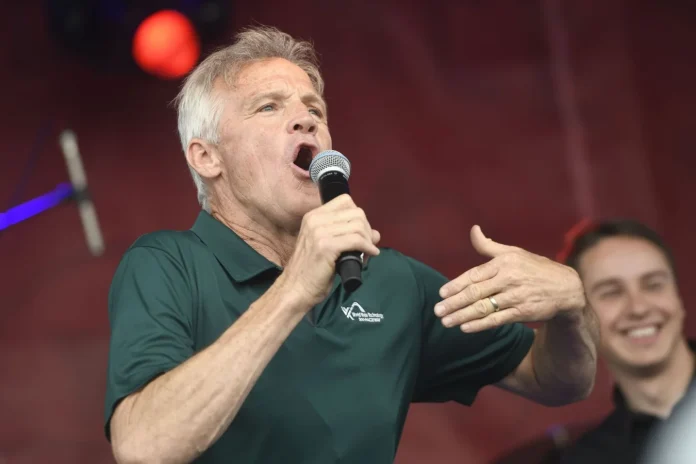The ongoing Kenny Wallace NASCAR future debate has sparked sharp disagreement among motorsports personalities regarding the sport’s potential for resurgence and the challenges in reconnecting with its traditional audience, igniting passionate viewpoints across the racing community. The recent clash centers on whether NASCAR can ever regain its former dominance or if it must adjust to new realities in a changing American sports landscape.
Public Disputes Over NASCAR’s Ceiling and Revival
When Kenny Wallace revisited and amplified his claim that NASCAR would never return to its previous heights, the conversation quickly escalated among fans and insiders. Wallace pointed out the vast difference between NASCAR’s past 200,000-fan crowds and its current position in the American media hierarchy, highlighting how the NFL has become the lone outlier in terms of mass popularity.
“I’ve been trying to teach you all that nothing is big anymore. Only the NFL. SEE this picture.”
This assertion prompted Toby Christie, Editor-in-Chief of Racing America, to push back forcefully, arguing that defeatist attitudes threaten the sport’s momentum and potential future.
“I completely respect @Kenny_Wallace, but I have never been a fan of the giving up, ‘we’ll never see that again,’ thought process in regard to #NASCAR’s popularity. The sport can only go as big as you believe it can be. It was once MASSIVE and I fully believe it can be again,” Christie wrote.
The disagreement is grounded in television ratings and audience comparisons. According to viewership data, the NFL continues to dominate the U.S. TV sports scene, with a 2024 per-game average of 17.5 million viewers and 70 of the nation’s top 100 broadcasts. NASCAR, in comparison, averaged 2.87 million viewers in 2024, with its season finale attracting about 2.92 million—numbers that have remained relatively stable from the prior year but are a fraction of the NFL’s audience.
Within motorsports, however, NASCAR remains far ahead. On the first weekend of August, Formula One’s Hungarian Grand Prix drew 1.22 million viewers, while IndyCar‘s Toronto race lagged behind with under a million. During the same period, NASCAR’s Iowa event attracted 2.17 million on USA Network, nearly doubling Formula One’s crowd and outperforming IndyCar by a large margin, though this represented a dip from earlier numbers.
NASCAR’s Evolving Audience and the Fight To Bridge Generational Gaps
Despite concerns about growth limits, NASCAR has invested in reaching new demographics, especially younger fans and digital viewers. This expansion, however, has come as its traditional base—often characterized as blue-collar and Southern—feels increasingly overlooked or alienated.
Recent shifts in the sport’s schedule and new media deals, such as street races in Chicago and Mexico and digital-first partnerships with streaming platforms like Amazon Prime and Netflix, reflect a deliberate attempt to broaden NASCAR‘s appeal and geographic footprint. While these tactics have successfully pulled in fresh eyes, veteran fans contend that the heart and soul of the series have faded, sparking consternation among its most passionate supporters.
Leadership Tackles NASCAR’s Identity and Brand Challenges
NASCAR executives are now pursuing a visual and cultural rebrand to reconnect with disaffected fans. According to Ewan Larkin of Ad Age, the organization is searching for a new lead creative agency to focus on restoring ties with its core blue-collar audience, an initiative involving eleven agencies and expected to conclude before September. The ultimate objective is to unveil a major campaign at the 2026 Daytona 500, aiming to revitalize nostalgia and win back those who feel left behind by recent changes.
“Some past efforts to reach younger and newer fans may have caused us to lose our way with our core fans,” admitted NASCAR Chief Brand Officer Tim Clark (via Sports Buisness Journal)
Kenny Wallace offered an emotional response to the organization’s admission, criticizing what he sees as a long-standing disregard for loyal followers of the sport.
“I specifically addressed a situation that was embarrassing… NASCAR said they’ve hired a firm to help them how to go about communicating, winning back the old fans, the blue-collar fans. And I found that appalling… Oh my God, how embarrassing. You’re admitting that you dumped the blue-collar fans, and now you’ve got to somehow win them over? This has been going on for 25 years.” (6:20 onwards)
Many traditional fans share Wallace’s agitation, observing that NASCAR’s push into new urban and international markets, as well as its partnerships with tech giants, has coincided with what they perceive as a dilution of the series’ Southern, grassroots heritage. Yet from an executive standpoint, these moves have achieved their intended growth among targeted demographics, extending NASCAR’s reach through streaming and global engagement.
The struggle to balance these competing interests has left longtime supporters questioning NASCAR‘s direction. Whether this marketing reset and agency shift can restore harmony and reverse the decline among older, blue-collar enthusiasts is still uncertain. The Kenny Wallace NASCAR future debate continues to shine a harsh light on the significance of identity, tradition, and modernization within America’s top motorsports series, fueling ongoing tension about the sport’s next chapter and its efforts to resonate with both new audiences and those who built its foundation.


